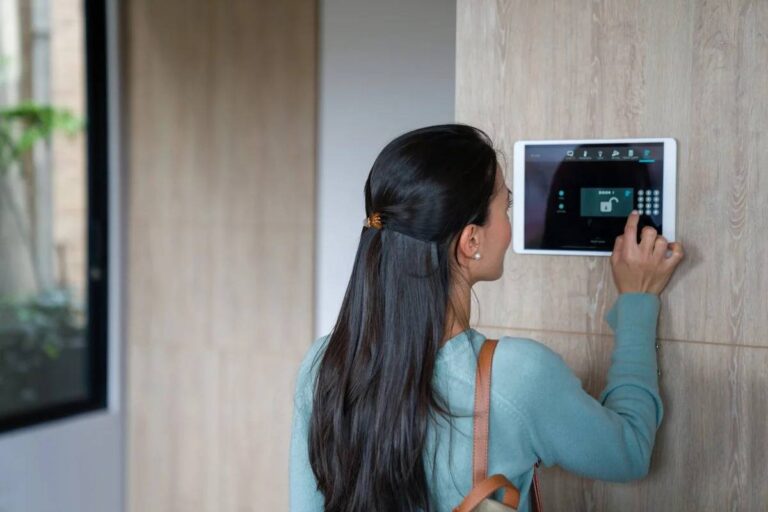When it comes to keeping our homes safe, we’ve come a long way from just deadbolts and window locks.
With all the crazy stuff happening out there from break-ins to package thieves, having some extra protection just makes sense. In today’s article, we’re gonna look at the best smart devices that can keep your home and family safe.
Before we dive into all these gadgets, I gotta say that my house has been slowly turning into this mini tech fortress over the past couple years.
And honestly? I sleep better at night knowing I’ve got these little digital guardians working 24/7.
You might not need everything we talk about here, but even just a couple of these devices can make a huge difference.
Best Smart Devices To Protect Your Home Overview
Smart home security isn’t just for tech geeks anymore. It’s become super accessible for pretty much anyone who wants to beef up their home protection.
Let me walk you through some of the best options out there right now.
Smart Security Cameras
If I had to pick just one smart device for home security, cameras would probably be my go-to. The peace of mind from being able to check on your house anytime is just awesome.
I installed a couple cameras around my place last year, and they’ve already caught someone trying to sneak into my backyard at 2 AM.
Got the alert on my phone, turned on the lights remotely, and watched them run away like they saw a ghost!
Most smart cameras now have cool features like motion detection, night vision, and two-way talk. Some of the newer models can even tell the difference between people, animals, and cars.
According to a recent study by Safe Home Security, homes with visible security cameras are 300% less likely to be targeted by burglars. That’s pretty huge!
For outdoors, I really like cloud security camera, as they have capacity to store tons of GBs of data on cloud. Means, you will never lose a recording.
For indoors, the Google Nest Cams have been super reliable for me. Just make sure whatever you get has cloud storage or local storage options so you can actually save your footage if something happens.
Smart Locks
Coming home with armfuls of groceries and fumbling for keys is the worst. Smart locks solve that problem and add a ton of security features too.
The coolest thing about smart locks isn’t just going keyless, it’s all the control you get. You can give temporary access codes to dog walkers or that friend who’s watering your plants while you’re in Hawaii.
You can check if your door is locked from anywhere in the world. And you get notifications anytime someone enters or leaves.
I put the August Smart Lock on my front door about six months ago, and it’s been a game changer. Last week I was already at work when my son texted that he forgot his homework.
I unlocked the door remotely so he could grab it, then locked it again once he was out. Pretty cool, right?
Just remember that most smart locks need good WiFi connection and batteries that need changing every few months. Small price to pay for never getting locked out again!
Smart Video Doorbells
Video doorbells might be the most popular smart security device out there, and for good reason. They let you see who’s at your door whether you’re in the bathroom or on vacation in another country.
These things are absolute gold for stopping package theft. According to a survey from SafeWise, about 14% of Americans have had packages stolen from their doorstep.
With a video doorbell, you can see when deliveries arrive and ask drivers to hide packages if you’re not home.
I’ve had the Ring doorbell for almost two years now, and it’s caught everything from delivery people throwing packages to neighborhood kids playing ding-dong-ditch.
The two-way talk feature is great for pretending you’re home even when you’re not. “Just leave the package at the door, thanks!” works like a charm from 500 miles away.
Smart Lighting for Security
Smart lighting isn’t just convenient, it’s actually really good security tech. Most break-ins happen at night, and lights that can mimic human behavior are super effective at deterring would-be burglars.
Setting up routines that make it look like someone’s home is pretty simple. I’ve got my Philips Hue lights programmed to turn on and off in different rooms throughout the evening when I’m away.
From outside, it totally looks like someone’s moving around the house.
Motion-activated outdoor lights are another must-have. When something triggers the motion sensor, lights blast on and suddenly that sneaky person is standing in a spotlight.
Nobody wants that kind of attention when they’re up to no good!
The coolest part is you can connect these lights to other security devices. My setup turns on specific lights if the doorbell camera detects motion after dark. It’s like having your own security system that responds automatically.
Smart Alarm Systems
Traditional alarm systems are great, but smart alarms take home security to a whole new level. These systems connect all your security devices and give you total control from your phone.
Most smart alarm systems come with door and window sensors, motion detectors, and a base station that ties everything together. What makes them “smart” is how they communicate with you and other devices.
I recently switched from my old-school alarm to SimpliSafe, and the difference is night and day. When a sensor gets triggered, I instantly get a notification showing exactly which door or window was opened. I can check my cameras right from the same app, and decide if I need to call the police.
According to FBI data, homes with alarm systems are up to 300% less likely to be broken into. That’s pretty compelling evidence that these things work!
Smart Sensors
When we talk about home protection, it’s not just about burglars. Sometimes the biggest threats come from water leaks, fire, or carbon monoxide.
Smart sensors can detect these problems early and potentially save you thousands of dollars in damage or even save lives. Water sensors under sinks or near washing machines can alert you the moment a leak starts. Smoke and CO detectors can send alerts to your phone even when you’re not home.
I learned this lesson the hard way when my water heater leaked while I was on vacation last year. Came home to damaged floors and a fat bill. Now I’ve got water sensors in all the danger zones, and they’ve already caught a small leak under the kitchen sink before it became a disaster.
Smart Hubs & Assistants
Smart hubs are like the conductors of your smart home orchestra. They help all your different devices talk to each other and work together.
With a good hub like Samsung SmartThings or Amazon Echo, you can create routines that trigger multiple devices at once. For example, when you say “Alexa, goodnight,” it could lock all doors, turn off lights, and arm your security system.
About 69% of smart home users say voice assistants have become essential to their daily routine, according to a 2023 survey. I use mine constantly to control security features hands-free. “Alexa, show me the front door camera” is something I probably say at least twice a day.
All-in-One Home Security Systems
If piecing together individual components sounds overwhelming, all-in-one security systems might be perfect for you. These packages come with everything you need already designed to work together.
Companies like Ring, Abode, and Cove offer complete systems with professional monitoring options. The monthly fees are typically much lower than traditional security companies, and you get all the smart features too.
My parents aren’t super tech-savvy, so I got them the Ring Alarm system last Christmas. The setup was surprisingly easy, and now my mom checks the app more than I do! She loves being able to see who’s at their door without getting up from her comfy chair.
Smart Thermostats
You might be wondering what thermostats have to do with security, but they’re actually really useful for home protection. Beyond saving money on energy bills, smart thermostats can prevent frozen pipes in winter and dangerous overheating in summer.
They also add to that “someone’s home” illusion when you’re away. A house that maintains normal temperature patterns doesn’t look abandoned to someone casing the neighborhood.
My Ecobee has paid for itself already by preventing what could have been a pipe-freezing disaster during an unexpected cold snap. It detected the temperature dropping too low and sent an alert so I could adjust the heat before anything froze.
Smart Plugs
Smart plugs are probably the cheapest and easiest way to add some security smarts to your home. These little devices let you control anything you plug into them from your phone.
You can use them to randomly turn on TVs or radios when you’re away, creating noise that makes it sound like someone’s home. They’re also great for controlling lamps in rooms that don’t have smart lighting.
I’ve got smart plugs on lamps in my living room and bedroom, programmed to turn on and off throughout the evening. Combined with a TV that occasionally turns on, it creates a pretty convincing illusion that someone’s home even when the house is empty.
How to Choose the Right Devices for Your Home?
With so many options out there, figuring out where to start can be tricky. Here’s my advice: think about your specific needs first.
If you’re in an apartment, your priorities might be different than someone in a house. For apartments, I usually suggest starting with a video doorbell (if you’re allowed to install one) and indoor cameras. For houses, outdoor cameras and door/window sensors typically make the most sense to start with.
Your budget matters too, obviously. If you can only get one or two devices right now, focus on the entry points most vulnerable in your home. For most people, that’s the front door and first-floor windows.
Another thing to consider is whether you want professional monitoring or self-monitoring. Professional services will call the police for you if something happens, but they cost monthly fees. Self-monitoring is free but puts the responsibility on you to respond to alerts.
According to security experts, about 40% of homeowners now choose self-monitored systems over traditional services with monitoring centers. It really comes down to personal preference and how comfortable you are managing your own security.
Tips for Maximizing Your Home Security
Here’re some of the tips to maximize your home’s security.
- Don’t hide your outdoor cameras. Visible security devices are proven deterrents.
- Make sure your WiFi network is secure with a strong password.
- Keep your devices updated with the latest firmware.
- Create unique, strong passwords for all your security apps.
- Test your devices regularly to make sure everything’s working properly.
- Consider adding battery backups for critical devices in case of power outages.
- Don’t share access codes with too many people.
- Use geofencing to automatically arm your system when you leave.
- Connect your smart security devices to each other when possible.
- Keep some security features private on social media.
Conclusion
Home security has come a long way from the old days of basic alarm systems. Today’s smart devices give us incredible control and awareness of what’s happening at home, whether we’re in the next room or across the country.
You don’t need to go all-in at once. Start with one or two devices that address your biggest concerns, then build from there as your budget allows. Even just a video doorbell or a couple of smart cameras can make a huge difference in your home’s security.
The peace of mind that comes from knowing your home is protected is seriously worth it. I sleep better knowing I’ll get an alert if anything unusual happens, and being able to check in anytime from my phone is pretty awesome.
What smart security devices are you thinking about adding to your home? Whatever you choose, your future self will probably thank you for the extra protection and peace of mind!



